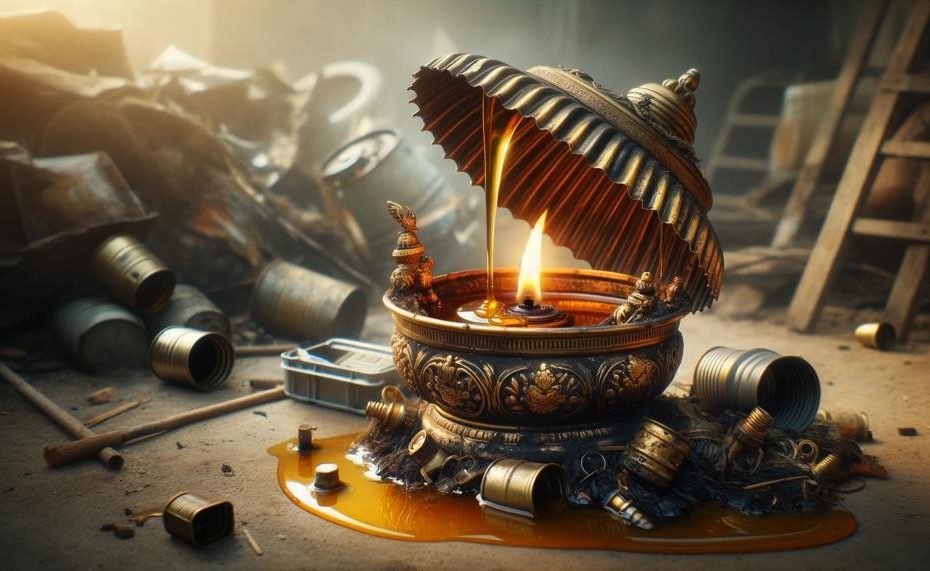Have you ever found yourself admiring the warm glow of a lamp, only to be left wondering what to do with the leftover oil? We have all the information you need on how to properly dispose of lamp oil. In this blog post, we will guide you through the best practices for disposing of lamp oil in an eco-friendly manner.
So, how do you dispose of lamp oil?
Here are some ways to dispose of lamp oil:
- Household hazardous waste (HHW) facility: Take it to a facility that will dispose of it properly. You can use the Earth911 Recycling Search to find a facility in your area.
- Oil change place: Any oil change place should be able to take it off your hands for a small disposal fee.
- Local fire department: Call your local fire department, they may either be able to take it, or they will know of a licensed disposal site in your area.
- Hazardous disposal day: Take it to your local landfill or dump for hazardous disposal day.
- Burn it off: Try small quantities in an outdoor fire pit or old steel can. You can add a bunch of cotton balls to a wide, flat pan (pie tin, for example), and have a mini-bonfire. This way, rather than potentially sending it to the trash heap, you can distribute the carbon in the oil throughout our atmosphere.
So, let’s get started and ensure that our love for lamps doesn’t harm our environment.
Contents
- 1 The Dangers Of Improper Disposal Of Kerosene Lamp Oil
- 2 Proper Storage Of Kerosene Lamp Oil To Prevent Accidents
- 3 The Best Way To Dispose Of Kerosene Lamp Oil
- 4 Eco-Friendly Ways To Recycle Or Reuse Your Leftover Lamp Oil
- 5 Can I Use Kerosene Lamp Oil to Safely Clean Outdoor Light Fixtures?
- 6 What To Do If You Can’t Dispose Of Kerosene Lamp Oil
- 7 Conclusion
The Dangers Of Improper Disposal Of Kerosene Lamp Oil
Proper disposal of kerosene lamp oil is crucial to prevent potential hazards, such as environmental contamination, fire risks, and damage to fixtures. It is essential to follow designated methods and guidelines for disposing of lamp oil safely and responsibly.
One major concern of improper disposal is the impact on the environment. When lamp oil is poured down drains or onto the ground, it can contaminate water supplies and harm the ecosystem. To avoid this, it is crucial to dispose of lamp oil at designated facilities or repurpose it into biodiesel.
Improper disposal of lamp oil also presents a fire hazard. Due to its highly flammable nature, improper disposal can pose a risk to individuals and property. To prevent this, it is vital to adhere to local guidelines and regulations for safe disposal of lamp oil.
In addition, improper disposal can also result in damage to fixtures. For example, using lamp oil as a cleaning agent for outdoor light fixtures can cause corrosion and other damage. To avoid any potential hazards, it is important to use mild, non-abrasive cleaners specifically designed for outdoor light fixtures.

To ensure safe disposal of kerosene lamp oil, here are some tips to follow:
- Check with local waste disposal facilities or recycling centers for specific guidelines.
- Seek advice from fire departments, environmental agencies, or waste management companies if no designated facility is available.
- Always use a tightly sealed, leak-proof container when transporting lamp oil for disposal.
- As a last resort, use an absorbent material to soak up the oil and dispose of it as solid waste according to local regulations.
- Never pour lamp oil down drains or sewers.
- Consider repurposing lamp oil into biodiesel or utilizing it for DIY projects instead of disposing of it.
- Follow proper cleaning methods for outdoor light fixtures using mild, non-abrasive cleaners specifically designed for them.
Proper Storage Of Kerosene Lamp Oil To Prevent Accidents
It is paramount to store kerosene lamp oil properly to keep your household safe and prevent accidents. To ensure the best practices are followed when storing kerosene lamp oil, here are some guidelines to follow:
- Opt for a suitable container: When storing kerosene lamp oil, it is imperative to use a container specifically designed for this purpose. A sturdy metal or plastic container with a securely fitting lid is highly recommended. Avoid glass containers as they can easily break and cause hazardous spills.
- Keep it in a well-ventilated area: Proper ventilation is essential when storing kerosene lamp oil to minimize the buildup of fumes. These fumes can be highly flammable and may ignite upon exposure to sparks or flames. Ensure that the storage area has proper ventilation to eliminate any potential hazards.
- Store away from heat sources and direct sunlight: Kerosene is a highly flammable substance and should be kept away from heat sources such as stoves, heaters, or direct sunlight. Exposure to high temperatures can cause the oil to expand and potentially ignite.
- Avoid storing near flammable materials: It is crucial to keep kerosene lamp oil away from any flammable materials like gasoline, paint thinner, or other household chemicals. These substances can easily ignite when exposed to kerosene fumes or spills.
- Keep out of reach of children and pets: To prevent accidents, make sure to store kerosene lamp oil in an area that is inaccessible to children and pets. Ensure that the container is securely closed and stored in a cabinet or on a high shelf.
- Label the container: Always label the container with its contents and the date of purchase. This will help you keep track of how long the oil has been stored and when it needs to be replaced.
- Dispose of properly: When disposing of kerosene lamp oil, it is crucial to follow designated methods and guidelines. Do not pour it down the drain or onto the ground as it can contaminate the environment. Contact your local waste management facility for proper disposal options.
The Best Way To Dispose Of Kerosene Lamp Oil
Disposing of kerosene lamp oil in an improper manner can have alarming environmental consequences. Kerosene, a highly combustible and poisonous substance, can cause extensive damage to the soil, water, and air if not disposed of correctly. The following are some potential risks associated with the incorrect disposal of kerosene lamp oil:
- Soil contamination: When kerosene is carelessly poured on the ground or disposed of in landfills, it can seep into the soil and contaminate it. This can have a detrimental impact on plants and animals living in the soil, as well as disrupt the delicate balance of the ecosystem.
- Water pollution: Kerosene is insoluble in water and can form a layer on the surface of bodies of water, preventing oxygen from entering and causing harm to aquatic life. Furthermore, if kerosene is disposed of incorrectly, it can contaminate groundwater, making it unsafe for human consumption.
- Air pollution: The burning of kerosene releases harmful fumes such as carbon monoxide, sulfur dioxide, and nitrogen oxides, contributing to air pollution and posing a threat to human health.
To ensure the safe disposal of kerosene lamp oil, it is best to take it to a designated hazardous waste facility. These facilities are equipped with the necessary tools and protocols to handle and dispose of hazardous materials appropriately, minimizing their impact on the environment. To locate the nearest hazardous waste facility, you can reach out to your local waste management authority for assistance.
In addition, here are some helpful tips for storing kerosene lamp oil safely until you are able to dispose of it:
- Use a suitable container: It is crucial to store kerosene in a container specifically designed for hazardous materials. A metal or plastic container with a tightly sealed lid is recommended.
- Ensure proper ventilation: Kerosene emits toxic vapors that can be harmful if inhaled. To prevent the buildup of these fumes, store the container in a well-ventilated area.
- Keep away from heat sources and flammable materials: Due to its highly flammable nature, it is essential to store kerosene away from any potential heat sources or flammable materials.
- Label correctly: Clearly label the container with the word “kerosene” and the date it was stored. This will help prevent any accidents or confusion in the future.
- Dispose of correctly: Under no circumstances should kerosene be poured down the drain, into the ground, or in regular garbage bins. Always take it to a hazardous waste facility for proper disposal.
Eco-Friendly Ways To Recycle Or Reuse Your Leftover Lamp Oil
Proper disposal of leftover lamp oil is vital for the safety of our environment and preventing hazards. Here are some environmentally friendly ways to recycle or reuse your leftover lamp oil:
- Utilize it as a lubricant: Don’t waste leftover lamp oil. Instead, use it as a lubricant for squeaky hinges or rusty tools. It’s an effective and eco-friendly alternative to petroleum-based lubricants.
- Create an all-purpose cleaner: Mix your leftover lamp oil with vinegar and water to create an all-purpose cleaner. This can be used to clean surfaces such as countertops, windows, and floors.
- Donate it: Consider donating your leftover lamp oil to local organizations or schools for use in science experiments. This is an excellent way to repurpose the oil and contribute to educational activities.
- Fuel for oil lamps or lanterns: During power outages, leftover lamp oil can serve as fuel for oil lamps or lanterns. Not only does this give the oil a second life, but it also provides emergency lighting.
- Recycle it: Some facilities accept used lamp oil for recycling. Check with your local waste disposal facility or recycling center for specific guidelines on how to properly dispose of your leftover lamp oil.
- Repurpose into biodiesel: Some companies specialize in converting used lamp oil into biodiesel, a cleaner-burning alternative to traditional diesel fuel. Consider contacting these companies to see if they can repurpose your leftover lamp oil.
Remember, never pour leftover lamp oil down the drain or sewer system as it can contaminate water supplies and pose a fire risk. Consult your local environmental protection agency for specific instructions on proper disposal in your area. By following these eco-friendly ways to recycle or reuse leftover lamp oil, you can help protect the environment and prevent potential hazards.
Can I Use Kerosene Lamp Oil to Safely Clean Outdoor Light Fixtures?
The answer is no. It is crucial to use a mild, non-abrasive cleaner specifically designed for this purpose to ensure both safety and effectiveness in the cleaning process.
Why should you avoid using kerosene lamp oil for cleaning outdoor light fixtures?
There are multiple reasons why kerosene lamp oil is not recommended for this task:
- Flammability: Kerosene lamp oil is highly flammable, which makes it dangerous for cleaning purposes. It has the potential to easily ignite and start a fire, putting both you and your property at risk.
- Toxic fumes: When kerosene lamp oil is burned, it releases toxic fumes that can be harmful if inhaled. These fumes can cause respiratory problems and irritation to the eyes, nose, and throat.
- Damage to fixtures: In addition to safety concerns, kerosene lamp oil can also damage the surface of outdoor light fixtures. The high concentration of chemicals in the oil can cause discoloration, corrosion, and even melting of plastic or rubber components.
- Environmental impact: Improper disposal of kerosene lamp oil can have a negative impact on the environment. The chemicals in the oil can contaminate soil and water sources, harming plants and wildlife.
What are some alternative methods for cleaning outdoor light fixtures?
- Mild soap and water: A simple solution of mild soap and water is usually enough to effectively clean outdoor light fixtures. This method is safe, effective, and environmentally friendly.
- Non-abrasive cleaners: There are many non-abrasive cleaners specifically designed for outdoor light fixtures that are safe to use and will not cause any damage. These cleaners are widely available at hardware or home improvement stores.
- White vinegar: White vinegar is a natural and effective cleaner that can be used to remove dirt and grime from outdoor light fixtures. Simply mix equal parts vinegar and water and use a soft cloth to wipe down the fixtures.
- Baking soda: Baking soda is another natural cleaning agent that can be used to clean outdoor light fixtures. Mix it with water to create a paste and use a soft cloth to gently scrub the fixtures.
What To Do If You Can’t Dispose Of Kerosene Lamp Oil
If disposing of kerosene lamp oil through traditional methods is not possible, there are alternative solutions you can explore.
These include utilizing designated hazardous waste disposal services, seeking guidance from local authorities, and finding creative ways to repurpose the oil for DIY projects or biodiesel production.
| Utilize Designated Hazardous Waste Disposal Services | If traditional methods are not feasible, designated hazardous waste disposal services can be contacted. These specialized services are equipped to properly and safely handle hazardous materials. They will ensure that the lamp oil is disposed of in an environmentally-friendly manner, minimizing harm to the ecosystem. |
| Seek Guidance from Local Authorities | If you are uncertain about the proper disposal of kerosene lamp oil in your area, it is best to contact your local authorities for direction. They may have specific regulations or guidelines on how to dispose of the oil responsibly. They may also be able to provide information on designated facilities or companies that handle hazardous waste disposal. |
| Get Creative and Repurpose the Oil | Kerosene lamp oil can be repurposed for various DIY projects or even converted into biodiesel. This not only reduces waste but also gives the oil a new purpose. Some ideas for repurposing lamp oil include creating homemade oil lamps or lanterns, using it as a lubricant for tools and machinery, or mixing it with other oils to make a natural insect repellent. |
Always use a tightly sealed, leak-proof container when transporting lamp oil for disposal. In case all else fails, you can absorb the oil with an absorbent material and dispose of it as solid waste according to local regulations.
Properly disposing of kerosene lamp oil is crucial to prevent environmental contamination and fire hazards. Never pour the oil down the drain or sewer system, as it can pollute water sources and pose a risk of spontaneous ignition.
Conclusion
In summary, the proper disposal of lamp oil is crucial to protect our environment and prevent potential hazards. It is important to note that lamp oil is a petroleum-based product and should not be disposed of down the drain or in regular trash. Instead, consider recycling or reusing the oil if possible. If not, it can be safely disposed of at a household hazardous waste facility.
Improper disposal of kerosene lamp oil can have severe consequences, including environmental contamination, fire risks, and damage to fixtures. To avoid these issues, it is essential to follow designated methods and guidelines for safe disposal. This includes using appropriate containers, keeping it away from heat sources and flammable materials, and labeling the container correctly.
If traditional disposal methods are not available, there are alternative solutions such as utilizing hazardous waste disposal services or repurposing the oil for DIY projects or biodiesel production. Always handle kerosene with caution and seek guidance from local authorities if unsure about proper disposal methods in your area.





